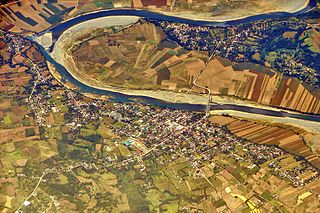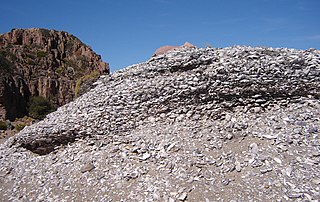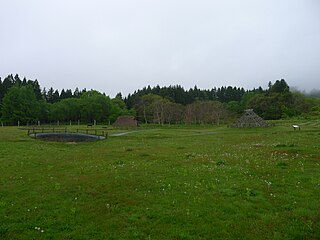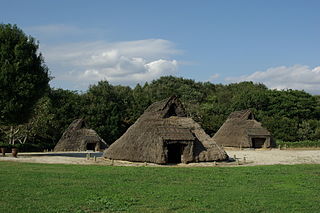The 20th century BC was a century that lasted from the year 2000 BC to 1901 BC.

The Cagayan River, also known as the Río Grande de Cagayán, is the longest river and the largest river by discharge volume of water in the Philippines. It has a total length of approximately 505 kilometres (314 mi) and a drainage basin covering 27,753 square kilometres (10,715 sq mi). It is located in the Cagayan Valley region in northeastern part of Luzon Island and traverses the provinces of Nueva Vizcaya, Quirino, Isabela and Cagayan.

Cagayan, officially the Province of Cagayan, is a province in the Philippines located in the Cagayan Valley region, covering the northeastern tip of Luzon. Its capital is Tuguegarao, the largest city of that province as well as the regional center of Cagayan Valley. It is about 431 kilometres (268 mi) northwest of Manila, and includes the Babuyan Islands to the north. The province borders Ilocos Norte and Apayao to the west, and Kalinga and Isabela to the south.

A midden is an old dump for domestic waste. It may consist of animal bones, human excrement, botanical material, mollusc shells, potsherds, lithics, and other artifacts and ecofacts associated with past human occupation.

Gattaran, officially the Municipality of Gattaran, is a 1st class municipality in the province of Cagayan, Philippines. According to the 2020 census, it has a population of 58,874 people.

Lal-lo, officially the Municipality of Lal-Lo, is a first class municipality in the province of Cagayan, Philippines. According to the 2020 census, it had a population of 48,733 people.
The legislative districts of Cagayan are the representations of the province of Cagayan in the various national legislatures of the Philippines. The province is currently represented in the lower house of the Congress of the Philippines through its first, second, and third congressional districts.

The Sannai-Maruyama Site is an archaeological site and museum located in the Maruyama and Yasuta neighborhoods to the southwest of central Aomori in Aomori Prefecture in northern Japan, containing the ruins of a very large Jōmon period settlement. The ruins of a 40-hectare settlement were discovered in 1992, when Aomori Prefecture started surveying the area for a planned baseball stadium. Archaeologists have used this site to further their understanding of the transition to sedentism and the life of the Jōmon people. Excavation has led to the discovery of storage pits, above ground storage and long houses. These findings demonstrate a change in the structure of the community, architecture, and organizational behaviors of these people. Because of the extensive information and importance, this site was designated as a Special National Historical Site of Japan in 2000., and a UNESCO World Heritage Site as part of the Jōmon Prehistoric Sites in Northern Japan collection in 2021. Today the public can visit the site, its various reconstructions of Jōmon structures, and a museum that displays and houses artifacts collected on the site, which have collectively been designated an Important Cultural Property
Cagayan North International Airport, sometimes referred as Lal-lo International Airport, is an airport serving the general area of the Cagayan Special Economic Zone, located in the northern province of Cagayan, Philippines. It is located between the Barangays of San Mariano and Dagupan in Lal-lo, Cagayan and is accessible via Magapit–Santa Teresita Road. The airport has been built to support the Cagayan Special Economic Zone in northern Cagayan, in tandem with Port Irene that will handle seaborne traffic. The airport is currently served by the charter airline Royal Air Philippines.

The Magapit Protected Landscape is a protected area of forested limestone hills and grasslands in the Cagayan Valley of northern Luzon island in the Philippines. It covers an area of 3,403.62 hectares in northeastern Cagayan province straddling the municipalities of Lal-lo and Gattaran. The park was established as a game refuge and bird sanctuary on 15 August 1947 covering an initial area of 4,554 hectares declared through Administrative Order No. 10 by President Manuel Roxas. On 23 April 2000, the park was redesignated as a protected landscape area under the National Integrated Protected Areas System Act through Proclamation No. 285 signed by President Joseph Estrada. The park is a component of the Northeastern Cagayan Key Biodiversity Area and also contains the Lal-lo and Gattaran Shell Middens, a proposed World Heritage Site.

The Futatsumori Site, known primarily in Japanese as the Futatsumori Shell Mound, is an archaeological site consisting of a series of large shell middens and the remains of an adjacent settlement from the Jōmon period, located in what is now part of the town of Shichinohe in Aomori Prefecture in the Tōhoku region of northern Japan. It has been protected by the central government as a National Historic Site since 1998. The site covers an area of about 30 hectares.

The Chōshichiyachi Shell Midden is an archaeological site in what is now part of the city of Hachinohe, Aomori Prefecture, in the Tōhoku region of northern Japan, with an initial Jōmon period shell midden. The site was designated a National Historic Site of Japan in 1981 by the Japanese government.

The Korekawa Site is an archaeological site in the city of Hachinohe, Aomori Prefecture, in the Tōhoku region of northern Japan containing the ruins of a middle to late Jōmon period settlement. The remains were designated a National Historic Site in 1957 by the Japanese government. It is also referred to as the "Korekawa Stone Age site", although the remains discovered are from the Jōmon period, rather than the Japanese Paleolithic period.

The archaeology of the Philippines is the study of past societies in the territory of the modern Republic of the Philippines, an island country in Southeast Asia, through material culture.

The Tagoyano Shell Midden is an archaeological site in what is now the city of Tsugaru, Aomori Prefecture, in the Tōhoku region of northern Japan with an early Jōmon period shell midden. The site was designated a National Historic Site in 1944 by the Japanese government. It is a rare example of a shell midden to be found near the coast of the Sea of Japan.

Cagayan Valley Road is a 121.216-kilometer (75.320 mi) major highway that connects the cities and municipalities of the province of Cagayan, Philippines.

The Ōfune Site is an archaeological site consisting of a series of large shell middens and the remains of an adjacent settlement from the Jōmon period. The site is in what is now part of the city of Hakodate in Oshima Subprefecture on the island of Hokkaido in northern Japan. It has been protected by the central government as a Historic Site since 13 August 2001. The site covers an area of 71.832 square kilometers.

The Kakinoshima site is an archaeological site consisting of a series of large shell middens and the remains of an adjacent settlement from the Jōmon period. The site is in what is now part of the city of Hakodate in Oshima Subprefecture on the island of Hokkaido in northern Japan. It has been protected by the central government as a Historic Site since 7 February 2011. The site covers an area of 92.749 square kilometers (35.811 sq mi).

The Kamitakatsu Shell Midden is an archaeological site in the Shishitsuka, Kamitakatsu, and Nakatakatsu neighborhoods of the city of Tsuchiura, Ibaraki Prefecture, in the northern Kantō region of Japan containing a late Jōmon period shell midden. The site was designated a National Historic Site in 1977.















